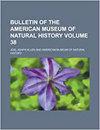Late Quaternary Fossil Mammals from the Cayman Islands, West Indies
IF 5.1
2区 环境科学与生态学
Q1 BIODIVERSITY CONSERVATION
Bulletin of the American Museum of Natural History
Pub Date : 2019-03-04
DOI:10.1206/0003-0090.428.1.1
引用次数: 18
Abstract
ABSTRACT Abundant fossils of nesophontid lipotyphlan insectivores and capromyid rodents have been collected from late Quaternary deposits on the Cayman Islands, an island group separated by a major marine barrier from other Caribbean landmasses and isolated from anthropogenic impacts until the arrival of Columbus in 1503 CE. These collections have not previously been formally described. Using morphological and ancient DNA approaches, we document three new taxa of extinct endemic terrestrial mammals from this island group: Nesophontes hemicingulus (Grand Cayman and Cayman Brac), Capromys pilorides lewisi (Grand Cayman, Little Cayman, and Cayman Brac), and Geocapromys caymanensis (Grand Cayman and Cayman Brac). Morphometric comparisons with other extinct and living West Indian mammals indicate that the biogeographic origins of all three new taxa are from source populations on Cuba. Ancient DNA data indicate very low sequence divergence of Capromys pilorides lewisi from mainland Cuban C. pilorides (only 0.5% across the entire mitogenome). Using probabilistic analysis of existing and new radiometric dates, we calculate an estimated extinction date of 1700 CE (95% confidence interval = 1632–1774 CE) for the Cayman Brac Capromys population. This result suggests that at least one endemic Cayman terrestrial mammal population survived for well over a century following first European arrival in the Cayman Islands. The West Indies lost nearly all its species-rich late Quaternary land mammal fauna during the late Holocene due to direct or indirect human impacts, and this study provides a new baseline to understand the magnitude of human-caused mammal extinctions during the recent past.西印度群岛开曼群岛的晚第四纪哺乳动物化石
摘要:从开曼群岛第四纪晚期的沉积物中采集到了大量的脂虫目食虫动物和盖层啮齿类动物化石。开曼群岛是一个被主要海洋屏障与其他加勒比海陆地隔开的岛屿群,在公元1503年哥伦布到来之前,一直与人类活动隔绝。这些藏品以前没有被正式描述过。利用形态学和古DNA方法,我们记录了该岛群中三种已灭绝的特有陆生哺乳动物的新分类群:半隐鼻蛙(大开曼和开曼Brac)、长毛犀(大开曼、小开曼和开曼Brac)和开曼岛土犀(Grand Cayman和Cayman Brac)。与其他已灭绝和现存的西印度哺乳动物的形态计量学比较表明,所有三个新分类群的生物地理起源都来自古巴的原始种群。古老的DNA数据表明,长毛羊与古巴大陆长毛羊的序列差异非常低(在整个有丝分裂基因组中仅为0.5%)。通过对现有和新的辐射测量日期的概率分析,我们计算出开曼Brac-Capromys种群的估计灭绝日期为1700 CE(95%置信区间=1632–1774 CE)。这一结果表明,在欧洲人首次抵达开曼群岛后,至少有一个特有的开曼陆生哺乳动物种群存活了一个多世纪。由于人类的直接或间接影响,西印度群岛在全新世晚期几乎失去了所有物种丰富的第四纪晚期陆地哺乳动物,这项研究为了解最近人类造成的哺乳动物灭绝的规模提供了一个新的基线。
本文章由计算机程序翻译,如有差异,请以英文原文为准。
求助全文
约1分钟内获得全文
求助全文
来源期刊
CiteScore
7.90
自引率
2.90%
发文量
4
审稿时长
>18 weeks
期刊介绍:
The Bulletin, published continuously since 1881, consists of longer monographic volumes in the field of natural sciences relating to zoology, paleontology, and geology. Current numbers are published at irregular intervals. The Bulletin was originally a place to publish short papers, while longer works appeared in the Memoirs. However, in the 1920s, the Memoirs ceased and the Bulletin series began publishing longer papers. A new series, the Novitates, published short papers describing new forms.

 求助内容:
求助内容: 应助结果提醒方式:
应助结果提醒方式:


